To read my detailed match report on Tennis with an Accent, click here
Swiatek d. Kenin — Poland Garros ends with Iga’s fabulous flourish
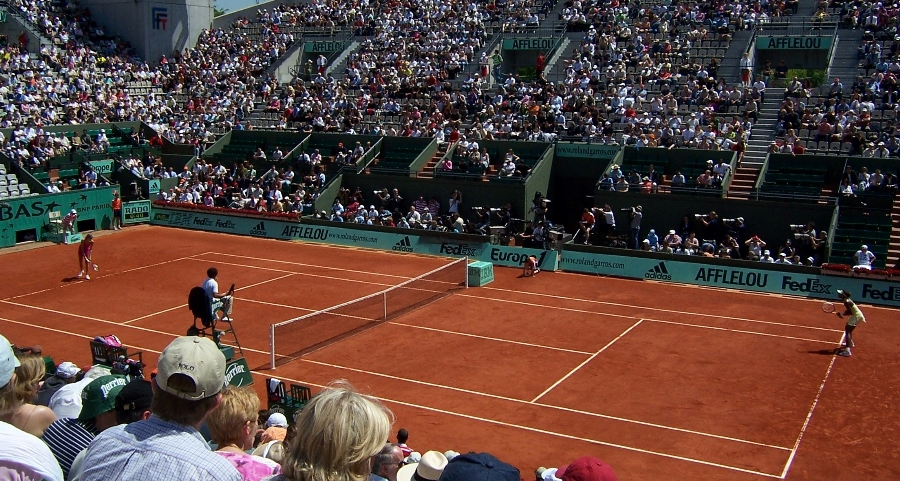
To read my detailed match report on Tennis with an Accent, click here
Swiatek d. Kenin — Poland Garros ends with Iga’s fabulous flourish

My match report and in-depth analysis of how Stefanos Tsitsipas recovered from a break down in the first set vs. Andrey Rublev, and earned himself a spot in the semifinals of the French Open, is now available on Tennis with an Accent at the following link:
Tsitsipas Overcomes Rublev’s Head Start
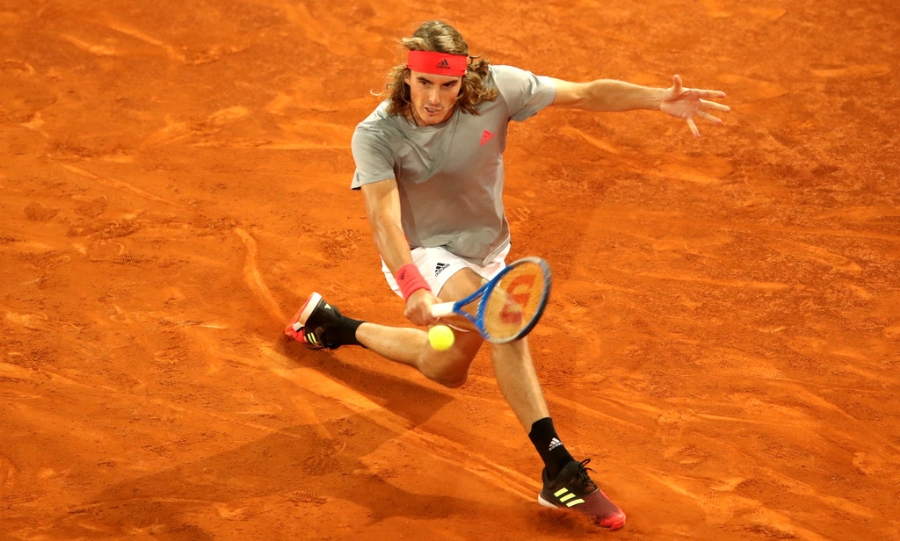
This unusual edition of Roland Garros in taking place in September and October of 2020 continues to showcase fresh faces and new talent. As we approach the end of the first week of competition in Paris, both draws are still filled with players who have never been past the first or second round of a Major in their careers — some having never even made it there. Consider Patricia Tig and Thiago Monteiro for instance, who have been ranked top-100 but never went past the second round of a Major before, or Barbora Krejcikova and Leylah Fernandez in the women’s draw, who are also in the third round for the first time, without ever having enjoyed a top-100 spot in the rankings in their careers.
Then, note players like Martina Trevisan, Hugo Gaston, Nadia Podoroska, and Sebastian Korda, Irina Bara, Daniel Elahi Galan, and Clara Burel, who have never won a match in the main draw of a Major until this week, but found themselves in a position to vie for a spot in the fourth round. Source: my knowledgeable friend Chris Oddo – @TheFanChild on Twitter, follow him if you are a tennis fan!
186th-ranked Daniel Altmaier belongs to the last group above. In fact, he had only played six tour-level matches in his career (2-4) prior to Roland Garros. He arrived to Paris for the qualifying rounds, not even knowing that he would have the opportunity to step on the court due to an injury that he suffered two weeks earlier at the Aix-en-Provence challenger, which forced him to retire from his semifinal match in the first set. He has battled his fair share of injuries in the past, including an elbow-related one in 2018 and shoulder problems later. It was after his arrival to Paris, on Friday before the qualifying competition, that the doctor finally cleared him to play.
Since then, he won six matches, losing only one set (none in the main draw), to find himself in the second week of the French Open. His latest victim was the 7th-seed Matteo Berrettini on Saturday on Court Philippe Chatrier.
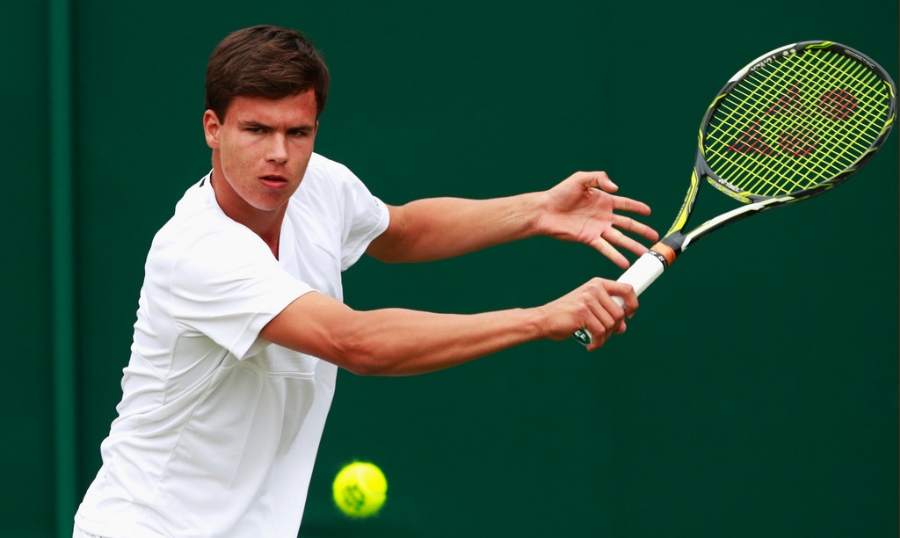
The 22-year-old German behaved as if performing on a big-stage court was nothing unusual for him, starting the match with remarkable energy and positive body language, both of which he sustained throughout the match. After an early break to go up 3-0, he never looked back and pocketed the first set 6-2 in 31 minutes. Berrettini, for his part, struggled not only with his backhands early in the set (nine unforced errors on that wing for the set — by my count), but also found himself off balance constantly, even when he did not miss, due to the versatile, power-oriented, solid all-court play of his opponent. Side note: Not surprisingly considering his game, a close look at Altmaier’s past results shows that he can perform on to all surfaces.
In the second set, Berrettini was somewhat able to steady the ship, cutting down on his backhand errors (only four in this set). It helped that he was able to break serve to start the set when he hit a forehand winner to take the lead in the game and Altmaier drove his one-handed backhand too deep on break point. Berrettini protected his break lead by using his bread-and-butter play, the 1-2 punch, until he served for the set at 5-4. But before I get there, allow me to elaborate on his 1-2 punch for a minute.
I realize that Matteo is one of the most efficient users of the 1-2 punch on the ATP Tour. He places his serve well and reads the opponent’s return early enough for the most part to move in position for the next kill shot, usually coming on his forehand. Even when not putting the ball away, he often produces a good enough second shot to take charge of the point, either putting his opponent on the run for the ensuing rally, or approaching the net to finish it with a volley.
What presents a problem at times, and it came into question in this match, is that he seems to rely too much on his forehand for the second shot, unnecessarily going out of his way to hit one. By that I mean, when his opponent hits a better-than-expected return toward his ad corner, he tries to run-around his backhand to still hit an forehand at the cost of not having his feet set, thus out of balance, and either makes an error on that second shot or hits an ineffective one which then allows his opponent to take charge of the point, producing the opposite effect of what Matteo was aiming for.
In the 2-1 game of the second set on his serve and up 40-30, for example, he served wide and moved slightly inside the baseline, expecting a defensive return from Altmaier who moved well outside the court for the return. The German hit a surprisingly deep cross-court return. Instead of getting set up to drill his backhand down-the-line to the open court for a possible winner (his backhand is solid, no idea what he would insist that much on avoiding it), Matteo attempted to take several short and quick steps to his left, and somewhat backward (because he had to back up due to his positioning following the serve), because he was simply determined to hit a forehand. The resulting off-balance forehand from the ad corner, while still moving left and leaning back, landed wide, giving the point to Altmaier.
That was just one example, and he managed to hold serve in that game, so it didn’t cost him at the end in that case, which brings me back to the 5-4 game where he tried the same thing and paid for it dearly this time. At 15-0, he once again forced the issue by running around his backhand to hit an out-of-sorts forehand on the second shot. It fell short and Altmaier jumped on the opportunity, accelerating his backhand sharp cross-court, and eventually winning the point it at the net. Berrettini’s shoulders slumped, probably regretting his decision. He hit an ill-advised drop shot into the net in the next point to go down 15-30. Three points later, Altmaier hit a beautiful passing shot to earn the break.
It all turned dour from that point forward for Berrettini and his poor decision-making came back to haunt him again later in the set. Serving at 4-5 in the tiebreaker, he missed a drop shot badly into the net when he could have done several other things with that shot from the middle of the court. He saved the first set point with a big first serve but missed the return in the net in the second to lose tiebreaker 5-7 and go down by two sets.
One last glimmer of hope for the Italian appeared when he was up 15-40 on Altmaier’s serve, leading 2-1 in the third. It disappeared quickly when Altmaier stood strong to come back and hold serve. That was all she wrote apparently, because in the ensuing game, Berrettini missed two routine forehands in the net and added a forehand volley to the tally of errors when he sailed it wide. It was a blank break game for Altmaier, with Berrettini muttering in Italian at one point, “I should be ashamed of the way I’m playing.”
The last game adequately summarized the match for Berrettini. Altmaier, serving for the match at 5-4 and on the verge of a monumental accomplishment from his perspective, made two unforced errors in the game, possibly from a bit of nerves (though I cannot tell for sure from his demeanor), but Berrettini topped him with four of his own to lose the game and exit the French Open.
“I was struggling to find the right attitude, the right energy. I was nervous. When I tried to calm down, I was too calm. I was struggling every single aspect of the game. It was a really bad day. I actually almost won a set playing like this, feeling like this,” said the Italian after the match. Source: @RaviUbna on Twitter.
Altmaier, realizing the magnitude of the moment, thanked everyone he knows in three different languages during the post-match, on-court interview, including his parents in Russian, whom he has been known to credit in the past for having encouraged him to play sports at an early age. His next opponent is Pablo Carreno-Busta who is no stranger to latter stages of Majors, having just defeated Roberto Bautista-Agut to reach the fourth round for the second time in Paris (2017, lost in the quarterfinal to Rafael Nadal).
Petra Kvitova (7) def. Jasmine Paolini 6-3 6-3
Convince me that there is a better first-striker than Petra Kvitova in women’s tennis. I dare you! I promise to keep an open mind, but you better have plenty of substance to support your pick. I don’t envy you. It will be difficult to find a player that can be held to the high standards of excellence put on display by the Czech champion in this category. She relentlessly stifles her opponents with explosive shots as soon as the first ball is in play, whether a serve or a return. Consider them lucky if they make it to the third shot, ecstatic beyond that.
Jasmine Paolini, her opponent of Thursday, would probably tell you all about it, assuming she has recovered.
As early as in the second game of the match, it was apparent that Paolini was feeling overwhelmed by the speed and power generated by Kvitova’s shots (it’s the first encounter). Paolini lost her serve on a double fault in that game to trail 0-2. That double fault went down in the stats as one of her five total for the match and too bad a foot note cannot be added to it. It would explain that it was the eighth point of that game, coming on the heels of seven crushing returns by Kvitova, two of them for clean winners. It would explain the urgency Paolini felt for a “great” (read: risky) second serve and the subsequent double-fault as the consequence. Later, Kvitova earned a second break for a 5-1 lead when Paolini double-faulted again under similar circumstances.
It was a vintage Petra performance, as she produced 15 clean winners for the set and won who knows how many other points that counted as Paolini’s “forced errors” only because her racket ‘touched’ the ball in full stretch.
The nightmare continued for Paolini in the second set. Exacerbating her problem was the fact that her usual strength lies in controlling the rallies with her ground strokes, especially her forehand. She can drill a mean inside-out winner on that wing at times and she generally prefers to stand close to the baseline, not minding taking balls on the rise if needed, which makes her game adaptable to both clay and hard courts. It’s true that her best results have come on clay but she has enjoyed some success on hard courts too.
Unfortunately for Paolini, that all seemed irrelevant in this match. Kvitova never allowed her to settle into her comfort zone, forcing her to a scramble for balls from the start of almost every point in the match.
Kivota’s next opponent is the young, talented left-handed Canadian player Leylah Fernandez. I presume that Fernandez is aware of the monumental task that awaits her. Is she ready for it? Can anyone really be ready for their first match against Kvitova? Don’t answer, rhetorical question.
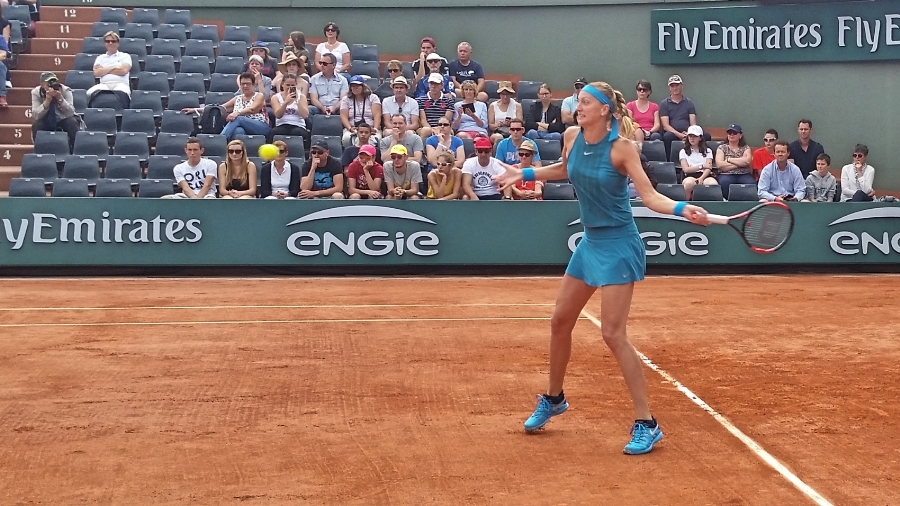
Sofia Kenin (4) def. Ana Bogdan 3-6 6-3 6-2
Here is one that should go down as Exhibit One on the topic of “problem-solving during a tennis match.” The Australian Open title holder Sofia Kenin overcame a dreadful start to oust Ana Bogdan of Romania in three sets.
Bogdan’s game relies on footwork and consistency first and foremost, but she can also generate pace from the baseline if needed. Her game was clicking on all cylinders in the first set, as she kept Kenin on the move and behind the baseline with a steady flow of deep shots (usually, Kenin is the one taking her opponents on scenic routs). She committed only four unforced errors** and, more importantly, took away Kenin’s ability to dictate the points. Kenin found herself in the unfamiliar position of retrieving balls rather than being the one to direct traffic and maybe that was the reason behind some of her 16 unforced errors in the set. In any case, her baseline play was erratic, to say the least.
** As always, I do my own count on unforced errors for reasons explained before. The official number may slightly vary.
It was not until around the third game of the second set (Kenin with 19 unforced errors at that juncture, Bogdan with 5) that the tide began to turn little by little. I know many observers will mention, with good reason, the numerous drop-shot winners that Kenin produced, but apart from that, she also started to push Bogdan further outside the court during rallies. She began using sharp cross-courts followed by flat accelerations to the open court. She also returned with more authority from the early moments of the second set forward.
Kenin grabbed a 3-1 lead but Bogdan, a terrific (and underrated) competitor, won eight points in a row, including three winners, to get back to 3-3. The difference was, as opposed to the first set, Bogdan now needed to be the one to push the envelope to win points because Kenin had already steadied the ship. She was making less errors and already throwing Bogdan out of balance in some rallies. By the time the score showed 4-3 in Kenin’s favor, the numbers were confirming the shift. The two were tied at 7 each in the unforced-error count for the second set, in comparison to the lop-sided 16-4 count in the first in Bogdan’s favor.
The 30-30 point in that eighth game was an apt representation of Kenin’s tactics in turning the match around. She made Bogdan chase after her aggressive shots behind the baseline (read: Kenin in full control) before she sneaked in a drop shot. Bogdan had to sprint forward from behind the baseline and barely got to the ball. She flipped it over the net, but it was an ineffective shot, and Kenin won the point with a passing shot. In the next point, Bogdan hit a fairly routine backhand wide to lose her serve. That error could have been the result of not having recovered from the previous point, or not feeling as confident as earlier in the match, or feeling the need to hit closer to the lines so that Kenin did not get to settle do the same to her. In any case, Kenin now led 5-3 and served for the set. She made all five of her first serves, finishing the set with a big one landing close to the “T.” Bogdan lunged and got her racket on it, but the ball never made it back into the court.
Primed and ready to take control of the match from the onset of the final set, Kenin executed beautifully in the first three games. She hit four drop-shot winners made zero unforced errors to go up 3-0. It’s not that Bogdan was falling apart — she was not, she made only one unforced error herself in that same span –, it’s just that she was rendered helpless by the pinpoint accuracy of her opponent’s shot placement. The bigger problem for Bogdan was that she had to now shift tactics and come up with solutions, and she simply lacked the necessary variety in her arsenal to try anything significantly distinct from her established Plan A. Perhaps, that is why she has not yet been able to reach the final of a Tour event or record a win against a top-10 opponent.
Kenin catapulted to a 5-1 lead a bit later and overcame a brief glitch in the last two games (7 of her 8 unforced errors in this set came here), before crossing the finish line on her 14th winner of the set. She will next take on the qualifier Irina Bara for a spot in the round of 16.
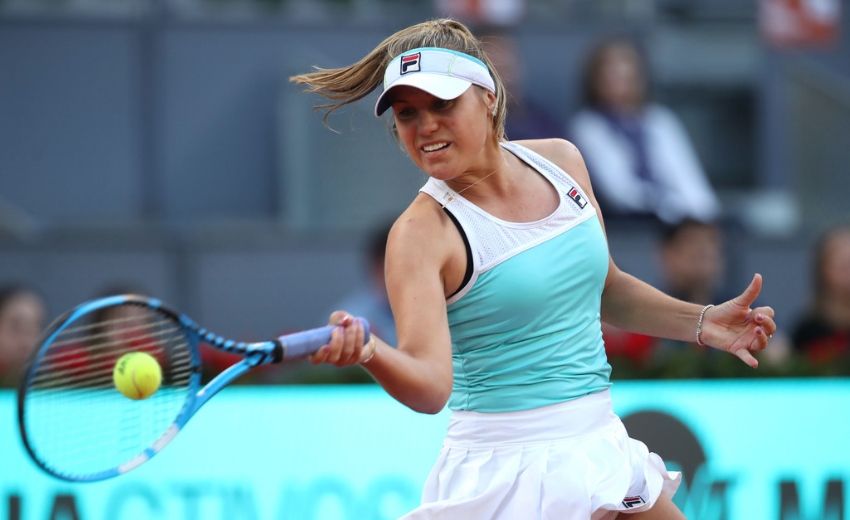
Paula Badosa def. Sloane Stephens (29) 6-4 4-6 6-2
Paula Badosa achieved a first in her tennis career, reaching the third round of a Major, at the same location where she won the junior girls’ titles in 2015 (photo below is from her semifinal win over Marketa Vondrousova that year). If you have followed Badosa’s career, her reaching the third round of a Major should not come as a surprise frankly, although it is her first time doing so. She has made considerable improvements to her game over the last two years (currently ranked 87, only one spot below her career best achieved in 2019) and had it not been for her pre-2018 struggles with injury, anxiety, and depression, she would have probably made it to this stage sooner. It’s nevertheless impressive to see how much better she is with her movement, ball placement (especially her backhand down-the-line), and decision-making. Note: It will be interesting to see how her tennis progresses forward from here forward considering that, after her semifinal appearance in Istanbul three weeks ago, she ended her two-year-long partnership with Xavi Budo, the coach she credits for the upturn in her career. Well, so far, no problem!
I would not be telling the full story of this match if did not mention that her opponent Stephens contributed just as much to this particular result as the progress in Badosa’s game. The Spaniard won eight out of nine points to start the match raced to a 2-0 lead, thanks to three winners of her own and three unforced errors by Stephens. The American held serve in the next game and caught up with Badosa at 4-4, but it was not because her game had recovered from the mediocre start. Errors were still coming in force (15 in the first set) and after a contested game that ended in Badosa’s favor for a 5-4 lead, the Spaniard won 12 of the next 15 points in less than 10 minutes to go up 6-4 2-0. The strange part was that Sloane was not even going for the lines. A significant portion of her errors came on shots aimed to the middle of the court, either sailing deep or slamming into the net. A number of them were actually short sitters! I kept wondering if she was ever going to try for more angles, or a change of pace, or maybe a drop shot or two, or something!
I finally noticed one such point with Badosa leading at 2-0 in the second set, when Stephens angled a forehand to push Badosa outside the court and hit the winner on the next shot to the wide-open ad side to grab the 30-15 lead. Two points later she held serve.
A second such point came in the next game, at 15-0 on Badosa’s serve at 2-1, when Stephens mixed in a slice backhand, followed by deep drive, and smacked her backhand down-the-line for a winner. Badosa still won that game to lead 3-1 when she hit a backhand down-the-line winner of her own (an example of one of the improvements I noted above), but Stephens was finally sinking her teeth in the match.
More importantly, Badosa was now having to worry about protecting her break lead until the end of the match, rather than just cruising along while Sloane’s errors piled up. That increased pressure on Badosa may well have been one of the reasons behind her first double fault of the match at 4-3, 30-30. Then, Stephens won the next point on a forehand winner and yelled out “Come on” for the first time in the match. It was maybe the most refreshing sound since it began, and that is coming from a neutral observer.
Now at 4-4 and Stephens serving, Badosa had a break point at 30-40 to reclaim the lead and serve out the match. Stephens drilled a forehand inside-out winner and yelled “Come on” again (with a fist pump this time) to deny her opponent the break. At deuce, another forehand winner gave her the ad, and she won the game with a powerful serve, taking a 5-4 lead.
When Badosa missed her backhand deep on set point one game later, Stephens let out her loudest and longest “Come On,” and for good reasons! She just won four games in a row to level a match in which she was behind most of the time. I thought at that moment that this match would end in a similar outcome as the previous one, with the player who has a Major title in her resumé (plus a Roland Garros final appearance in Sloane’s case) scoring a comeback victory. Not this time.
Badosa did not crumble despite squandering the set and 4-2 lead, and had a terrific start to the final set. After breaking Sloane’s serve in a close first game, she served her only two aces in the next one and added a winner to go up 2-0.
Apparently, that is all it took for the wheels to fall off for Stephens. She lost the next 8 points, six on routine mistakes, to find herself down 0-4. It is not that matches cannot have momentum swings, but this was a lightning-fast, baffling 180-degree turnaround of four games that sunk the same player who had just executed a dazzling 180-degree turnaround of four games of her own to get back into the match!
Badosa, stayed the course, completed the formalities, and closed the curtains down on Stephens by winning the last four points of the match at 5-2. She made only 13 unforced errors in the match (less than Stephens’s total in the first set alone), and only one in the final set. She was clearly the better player, thoroughly deserving of victory, and in retrospect, it’s astonishing that this match even extended to a third set. Take away the four-game stretch late in the second set, this was as lop-sided as a match can get in favor of one player. It proves, yet again, how unpredictable tennis is and how deceptive it can be to watch only certain parts of match.
Next for Badosa is another previous Major title winner, the 2017 Roland Garros champion Jelena Ostapenko.
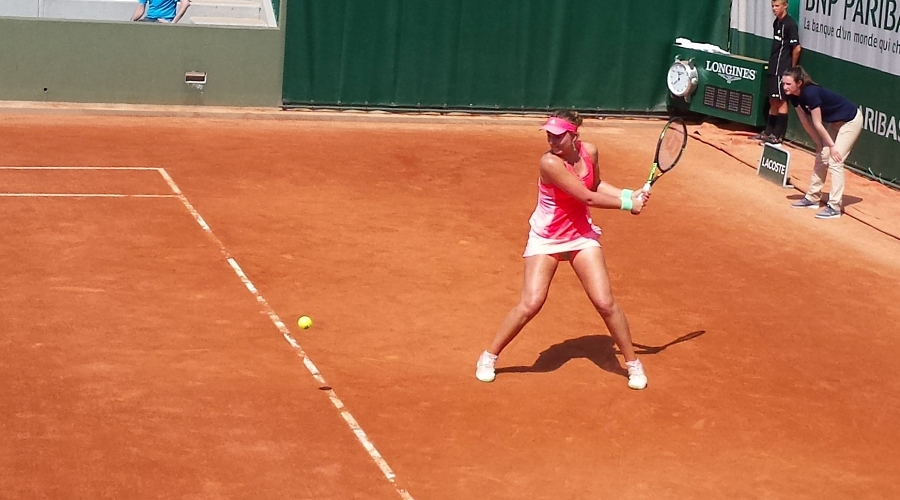
This encounter between the 16th seed Stan Wawrinka and Dominik Koepfer appeared to be intriguing on paper in the sense that you had one player who tasted glory more than once in the Majors but slipped off a bit in the aftermath of his knee injury (and operation) in the late-summer of 2017, and another who has been making significant progress into the top 100 ATP since the fall of 2019, currently enjoying his highest career ranking of 61.
I was interested in seeing where Stan stood with regard to his physical shape and his form (he hadn’t played the tournaments in the US, opting to begin his post-Coronavirus season on clay in Europe), and what tactics Koepfer would tap into in order to do challenge Stan’s potent game, so I decided to settle in front of the TV and watch the match with an early morning (5 AM) pot of coffee ready to be consumed.
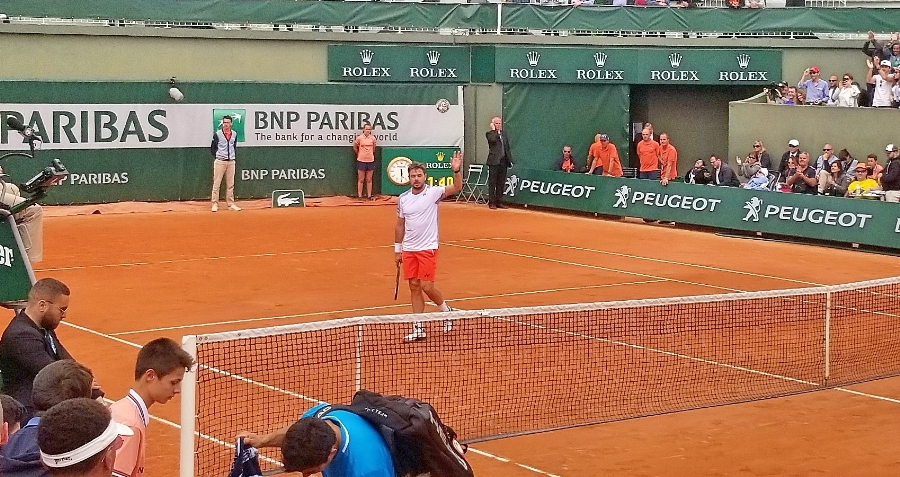
Both players began the match somewhat subdued, although it rapidly became clear that the amount of success Wawrinka was going to have with his accelerations, and how many of those Koepfer was going to be able to get back from far behind the baseline where he seemed to hang out, would determine the outcome of at least the first set.
The first key point arrived at break point for Wawrinka when Koepfer served at 1-2. That test ended in Koepfer’s favor when Stan missed an easy forehand approach deep.
Next came Koepfer’s chance to take charge of the set when he led 0-40 on Stan’s serve in the next game at 2-2. Koepfer missed a backhand in his first break-point chance and Stan erased the second one with forehand down-the-line winner (which shaped to become his bread-and-butter shot for the first two sets, along with the inside-out one), following it up with an overhead winner at the net to get back to deuce. He saved a fourth break point at ad-out with his signature backhand down-the-line acceleration that Keopfer could not get back, and eventually survived the game.
Little did the left-handed German know at that time that he would find himself down two sets before he could get a glimpse of another break-point opportunity. Wawrinka began to steadily raise his level from that point forward. Koepfer also played into Stan’s game (and continued to do so until the third set) by not testing the one area where he could have made some inroads, his lefty forehand cross-court to Wawrinka’s backhand, preferably in the form of a high-bouncing topspin to force Stan into making contact above his shoulder level on his one-handed backhand – remember how Nadal exploited that in the French Open final in 2017. Koepfer strangely tried this only once in the set, in the first point of the 4-3 game, and Stan framed the backhand for a mistake. I am at a loss for an explanation as to why he did not resort to that pattern more.
Koepfer did not serve enough wide serves on the ad-side either, something that he usually does well with his lefty slice serve, nor did he try to kick it high to the T on the deuce side, again making Stan start the point with his least favorite shot. Instead of defending high and deep during rallies, he tried to drive balls from far behind the baseline, giving Stan the pace that he seeks in order to generate his own explosive ground strokes.
As for Stan, I know that people cannot marvel enough over his backhand – and don’t misunderstand, I like it too – but as is usually the case, it was his underrated forehand that caused most of the damage. Koepfer found himself deeper and deeper in the back of the court to scramble for the barrage of Stan’s forehand accelerations which also allowed the Swiss to successfully chip in the occasional drop shot for good measure (not so successful after the first set though, I must note).
Koepfer’s armor suffered the its first dent in the 3-4 game on his serve (you could sense this coming from the way the match was developing) when he missed two cross-court backhands in a row wide at 15-15, putting him down two break points. Stan generously contributed to his opponent’s downfall with yet another thunderous inside-in forehand to gain the conclusive lead for the set. It was over in 34 minutes, 6-3 in Stan’s favor, a solid set in which he made seven unforced errors (my count) and 10 winners.
The second set was different in the sense that I am not sure if Koepfer could have done anything to stop the Wawrinka train. The Swiss was unstoppable, putting on full display the best version of vintage “Stan the Man” that many remember from his three runs to Major titles. It was one explosive shot after another, often leaving Koepfer helplessly watching balls zip by him meters away. Stan grabbed a 4-0 lead, hitting seven clean winners off ground strokes in that stretch, along with another half dozen accelerations that the German could not get back in the court. Just to illustrate how vulnerable Koepfer must have felt, he committed only three unforced errors in the second set, but lost it 6-2, probably having something to do with his opponent hitting 13 clean winners.
Koepfer, not one to fold no matter how insurmountable a challenge he faces, kept plugging away. And this time he appeared to make a couple of modifications to his game plan. For instance, he began to unleash on returns in effort to take away Stan’s 1-2 punch, and did finally add some high and deep cross-court forehands into the mix (though still not enough in my view, but see the 3-2, 15-0 point for one example).
He survived through two break points on his first two service games thanks to a more erratic Stan making an appearance in the third set. The pendulum eventually swung his way when Stan served at 3-4 and faced a break point at 30-40. The Swiss missed an inside-out forehand winner attempt wide and Koepfer earned his first (and only) break of the match. That point was also emblematic of the third set in general. In a complete reversal of the second set, and perhaps with an assist by Koepfer’s modifications noted above, Stan struggled to find the court whenever he went for winners. When the scoreboard showed 4-3, he had already committed 15 unforced errors (finished with 18), more than in the first two sets combined. His first-serve percentage also plummeted to 55% for the set, down from 75% in the previous one.
Koepfer appeared to have sunk his teeth into the match and the contested points in the very early portion of the fourth set seemed to confirm that. Until, that is, Koepfer unexpectedly missed two routine forehands in a row deep to find himself down 15-40 in the second game. Stan seized the opportunity with another acceleration on his forehand for the break. That is all it took for Stan to recapture his form of the first two sets and race to the finish line in less than 20 minutes, with the final score showing 6-3 6-2 3-6 6-1.
The match lasted two hours and eight minutes and there were plenty of encouraging signs for Wawrinka’s fans who are longing for another stellar run from their man in a Major. I am not convinced yet, because in a match where his opponent played into his game for the most part, he still showed enough glitches to inject some doubt into his capacity to consistently perform at his top level through a best-of-five-set encounter. Don’t get me wrong, he showed that his best is still within reach, especially during the second set and most of the first and fourth sets. He will undoubtedly need to iron out the bad patches though if the much-anticipated encounter with Thiem is to occur in the fourth round.
Wawrinka faces the wild-card participant Hugo Gaston next, so as far as lovers of spectacular one-handed backhands are concerned, their dream match remains very much within the realm of possibility.
As a guest on a few podcasts following the US Open, I argued that the semifinal match between Naomi Osaka and Jennifer Brady in New York was the most spectacular match of the tournament on the women’s side. The encounter featured rallies of extreme high pace, and whereas one may expect a notable dose of wild errors to accompany the potent shot-making in such cases, both women kept their game clean and increased their scintillating shot production instead as the match progresses. I was left wondering how in the world they did not mishit more balls at that velocity.
Tuesday morning at Roland Garros two weeks later, Brady was part of another high-quality match similar in posture to the one in New York, except that her opponent was not a proven performer at the elite WTA level with Major titles in her resumé like Osaka, but was rather the former world junior number one Clara Tauson, the 17-year-old Danish player, who stepped on Court Simonne-Mathieu for her first match in the main draw of a Major. She had only one main draw WTA Tour match in her record prior to entering the qualifying rounds at Roland Garros, a first-round loss at the Lugano event last year, after coming through qualifying. Let those last few lines sink in first. Then, consider what took place during the two hours and 45 minutes of this delightful outing, eventually ending 6-4 3-6 9-7 in favor of the youngster. Tauson not only matched Brady’s shot-making prowess at every juncture of the match, but also put on display the type of mental resiliency that usually defines top-notch performers on the WTA Tour.
Tauson survived two match points and persevered through the disappointment of not capitalizing on three of her own, before coming out on top on her fifth two games later, all taking place in the extended stages of the third set against a seasoned and in-form opponent whose level remained high throughout. It is not that Brady did something wrong and deserved to lose. It is rather Tauson who plucked away to victory by doing (almost) everything right.
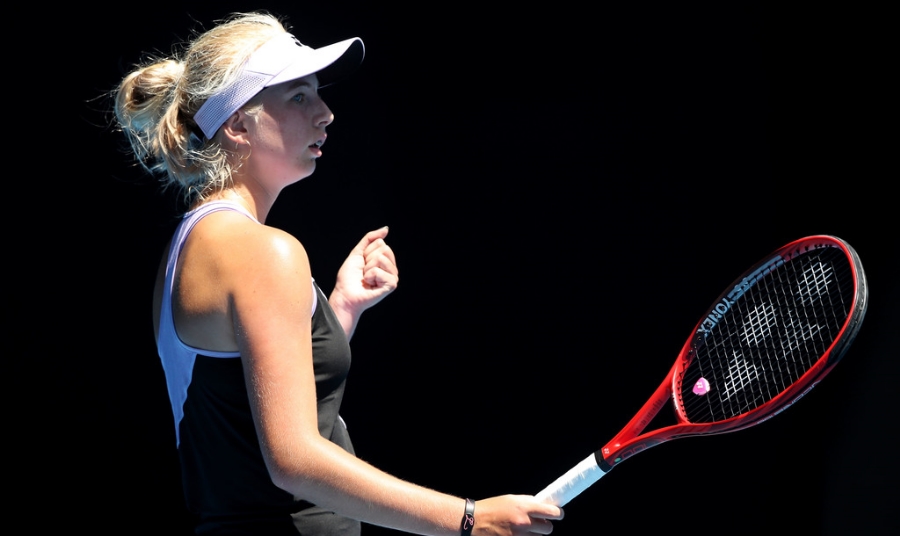
To hardly anyone’s surprise, especially to those familiar with Tauson’s game, both players began the match on fifth gear, nailing the ball in an effort to dominate rallies, leading to the first five points ending in direct winners.
At the end of three games, there were already a total of 13 winners on record, nine of them coming from Tauson’s racket. May I remind you that we heard repeatedly since the competition began, that the courts playing slower due to weather conditions and the newly adopted – and bigger – Wilson balls. Feel free to toss that observation in the back of the closet for this match.
Tauson broke Brady’s serve to grab an early 3-1 lead and you could tell Brady was already forced to put her high-IQ into overdrive to come up with answers to the overwhelming flow of powerful shots raining her way from the other side of the court. Tauson was generating most of her winners from either the middle of the court on her forehand (eight such winners, four to each corner) or from the ad corner with her backhand down-the-line (five of them in the set). So, Brady began testing the one unproven side in the match thus far and began pulling Tauson wide to her forehand side to see, I presume, if the youngster could effectively produce winners from that location on the court.
She first tried it for the first time at 0-15 on Tauson’s serve in that 3-1 game and it led to an error by the Danish player. Brady finished the game with a winner (one of her ten total) to get back on serve and doubled down on that particular pattern, taking away the two spots on the court from where Tauson was producing the most winners (see above).
At 2-3, 15-0 serving, Brady pushed Tauson again to the forehand corner, earning a short reply which she put away to the open court with her backhand. She followed that up with a strong wide serve to the deuce side, producing a similar result and leveled the set at 3-3 one point later. In the ensuing game at 30-30, Brady looked like she was on track to gain the lead when she once again stretched Tauson to her forehand corner and followed it up with a winner when Tauson’s reply fell short. She could not, however, take advantage of it when she returned the ball into the net on the following break point.
The problem for Brady, you see, was that Tauson is not some one-dimensional player who possesses only a single bag of tricks (read: strike every ball hard and aim for winners). She can hit angles as well from both wings and mix-in the occasional drop shot. On her serve, she has the ability to vary the amount of kick or slice. And lo and behold, she is not afraid to come to the net and use her fundamentally sound volleys (5 out of 8 on approaches to the net in the set). Brady forced Tauson to dig deep into her set of skills. Tauson responded by holding serve after a contested game that saw four deuces, thus halting the American’s progress.
Each player held serve one more time and the scoreboard showed Brady serving at 4-5. This is where Tauson rose to the occasion with the composure of a champion. She started the game with a booming return that Brady could not get back. Two points later, she struck her fourth backhand down-the-line winner to get the 15-30 lead. At 30-30, she came up with a drop-shot winner to earn a set point, where she finally received an assist from Brady who had been playing a clean game with only four unforced errors (my own count) until that moment. The American missed a backhand in the net on Tauson’s return.
Brady, too great a competitor to get discouraged, buckled down on her problem-solving dexterity and adopted an ultra-aggressive game plan to take away Tauson’s ability to direct traffic during rallies. She began pounding on returns at the cost of making mistakes (did not make many) in order to take charge from the get-go and not allow Tauson to continue generating power from comfortable spots.
Brady led 2-1 when Tauson called for a medical time-out due to an ailing thigh. When she emerged from the medical time-out with her upper left thigh bandaged, she was ready to go back to work, but the flow of high-octane shots by Brady coming her way eventually began to take their toll. Brady insisted on exploiting the wide forehand corner on Tauson’s side and took more risks on her second serves with successful results (see for example the last two second serves to the ad side in the 2-1 game, with Tauson having to strain to get them back whereas she was taking charge on second-serve returns in the first set).
Tauson began to show cracks in her game – totally acceptable, bound to happen at some point considering the circumstances from her perspective – toward the end of the set when she served at 3-5. She missed a makeable volley and hit a forehand sitter in the net, losing the set 6-3 on her tenth unforced error of the set.
Fast-forward to Tauson serving at 5-6 in the final set, when it looked like the exciting adventure was about to come to an end for her. She missed two forehand sitters in the net in the first four points to find herself down two match points at 15-40. Somehow, Tauson remained resolved and squeezed a return error out of Brady with her first serve to save one match point. Then, she got back to deuce after a terrific rally in which she fearlessly unleashed four huge shots (and another forehand down-the-line topspin that caught the back of the line), virtually beating an error out of Brady. For good measure, she hit a stellar forehand inside-out winner to equalize at 6-6.
It was all Tauson over the next five minutes or so, as she broke serve and earned her first match point at 7-6 serving, 40-15. She finally showed some signs of nerves, I presume, missing a forehand and a backhand deep in succession, allowing Brady to get back to deuce. She had another chance to put the match to rest two points later, but her drop-shot attempt ended in the net. On Brady’s second break-point chance, Tauson missed a short backhand when Brady’s floater skipped on the service line and bounced low. Just like that it was 7-7.
You would think that the 17-year-old would finally succumb to the magnitude of the moment and crumble away after squandering three chances to win the match, right? Wrong! Not Tauson.
She remained level-headed in a way that would make top players envious after the disappointment of the previous game and it was Brady who cracked with two unforced errors in a row at deuce, both landing deep, and giving Tauson a chance to serve for the match again at 8-7. Tauson did not let this game slip away. She saved a break point at 30-40 with her 48th winner of the match (yes, forty-eight!) and although another match point went by when Brady hit an amazing backhand cross-court winner, Tauson capitalized on her fifth one when she landed a first serve close to the “T” and Brady missed the forehand return wide.
Side notes:
— 48 winners to 38 for Tauson (official count says 46 unforced errors for Tauson) and 39 to 19 for Brady (official count says 25 for her unforced errors). Maybe not at the sky-high levels of the Osaka-Brady US Open semifinal that I mentioned in the beginning, but undoubtedly a quality match by any measure.
— I simply cannot rely on the official unforced-error count. Numbers have been significantly higher than in my counts in all four first-round matches I analyzed so far in this tournament. I’ve closely observed how the official count works. One example: a shot missed by a server following a hard return by the opponent ,landing inches away from the baseline, thus forcing the server to balance on their backfoot to hit a half-volley-like shot, is simply not an unforced error in my book. Another example: a return missed on a high-kicking second serve, one that forces the returner to strike above the shoulder level on a reach is not an unforced error.
— I cannot help but wonder why neither player gave a fair shot to the idea of using slice to see if they could collect errors from their opponent. Especially interesting that Brady stayed away from it so much (she has the shot in her arsenal), never forcing Tauson to hit a couple or three shots from the knee level or below.
— Tauson’s net stats are 14 out of 27, which makes me wonder if they take into account points where Tauson hit a potent shot, and seeing that Brady is on the run and is likely to float the next shot back, began moving to the net, but winning the point without having to volley because Brady’s retrieval never made it back on her side. I am fairly certain that Tauson’s attacking game had a better success rate than 52%.
Tauson takes on an another American next, the 57th-ranked Danielle Collins.